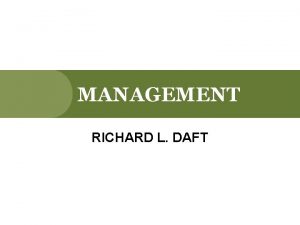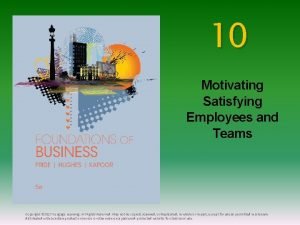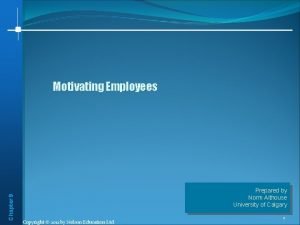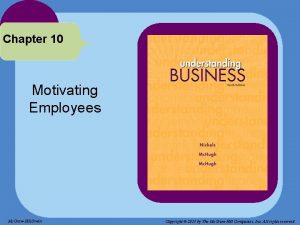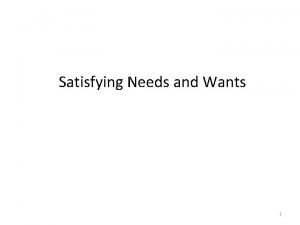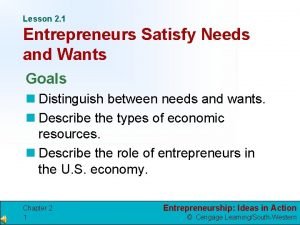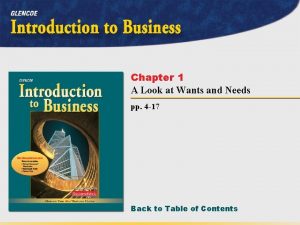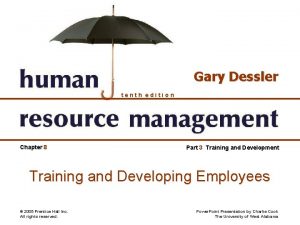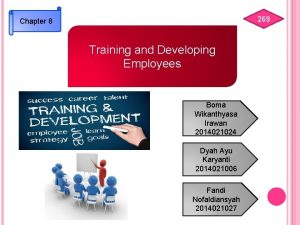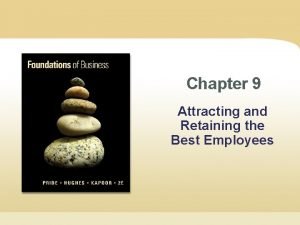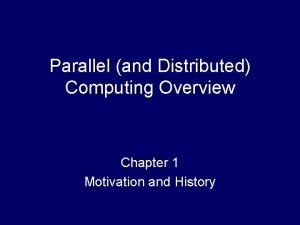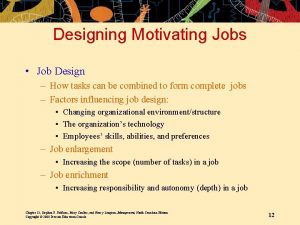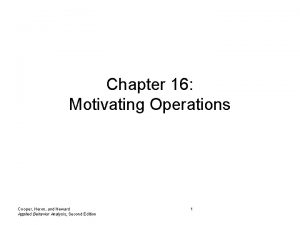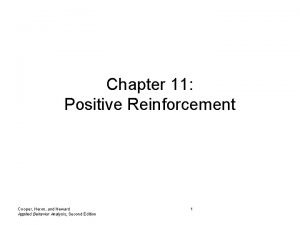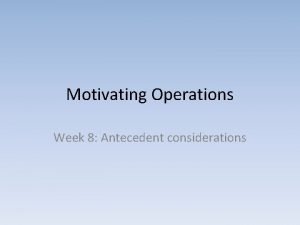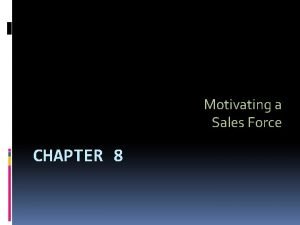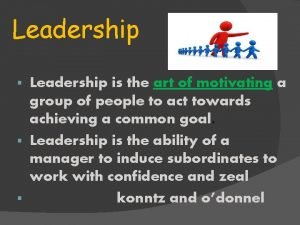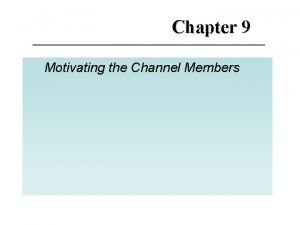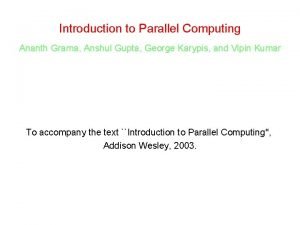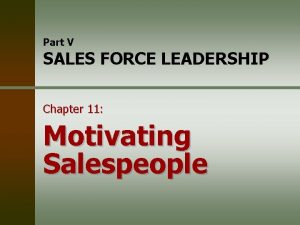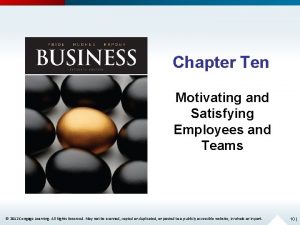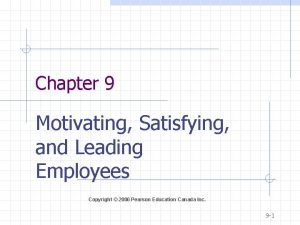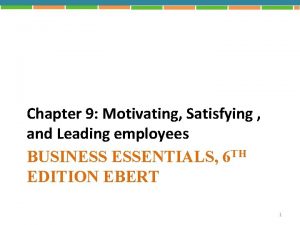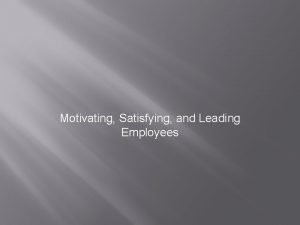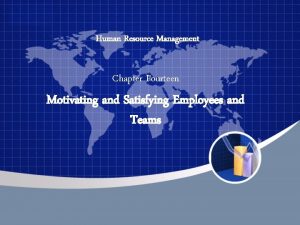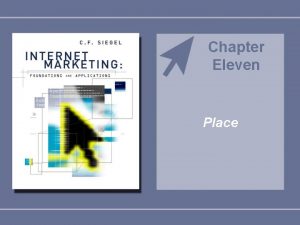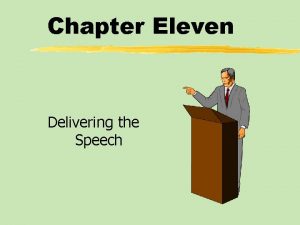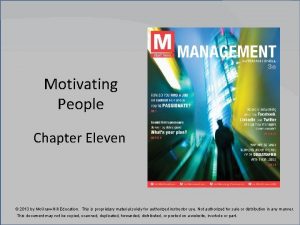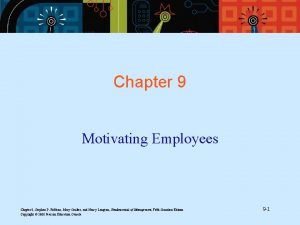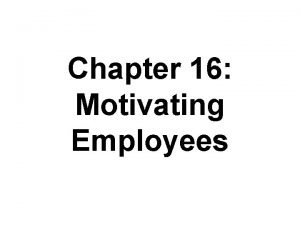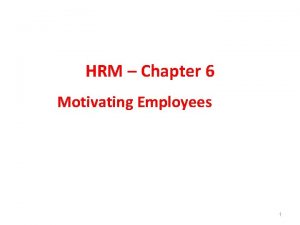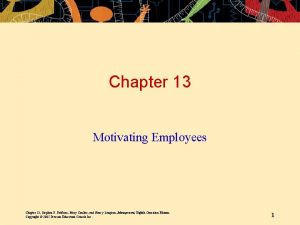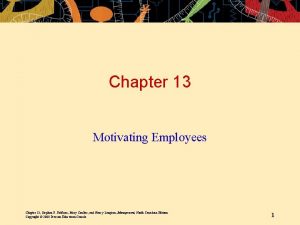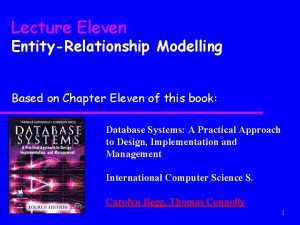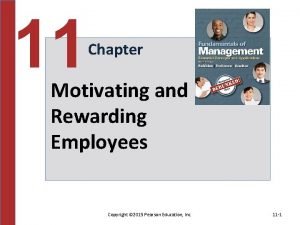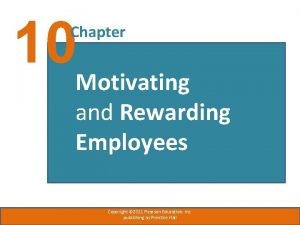Chapter Eleven Motivating and Satisfying Employees What Is


































- Slides: 34

Chapter Eleven Motivating and Satisfying Employees

What Is Motivation? Think about a time you were truly motivated to work hard. • What was the goal at the end of the hard work? • Was there ever a time when you were asked to work hard and you did not? • What was the difference? Copyright © Houghton Mifflin Company. All rights reserved. 11 - 2

Companies that get it right • http: //money. cnn. com/magazines/fortun e/bestcompanies/2007/full_list/ Copyright © Houghton Mifflin Company. All rights reserved. 11 - 3

Motivaiton • The the personal “force” that causes us to behave in a particular way • Morale – An employee’s feelings about his or her job and superiors and about the firm itself – High morale results from the satisfaction of needs or as a result of the job and leads to dedication and loyalty – Low morale leads to shoddy work, absenteeism, and high turnover rates Copyright © Houghton Mifflin Company. All rights reserved. 11 - 4

This chapter covers: • Motivation Research • Motivation Techniques Copyright © Houghton Mifflin Company. All rights reserved. 11 - 5

The Motivation Research • Historical views on Motivation • late 1800’s Scientific Method – Fredrick Taylor’s piece-rate system • • • 1927 - 1932 Hawthorne 1960 - 1970 Maslow’s Hierarchy of Needs Late 1950’s Herzberg’s Motivation-Hygiene Theory Mc. Gregor’s Theory X and Theory Y Ouchi’s Theory Z Reinforcement Theory • Contemporary views on Motivation • Equity • Expectancy • Goal Setting Copyright © Houghton Mifflin Company. All rights reserved. 11 - 6

Historical Perspectives on Motivation • Scientific Management – The application of scientific principles to the management of work and workers – Frederick W. Taylor • Late 1800’s • Observed “soldiering” by workers who feared losing their jobs if there were no work • Job should be broken into separate tasks • Management determines the best way and the expected output • Management chooses and trains the best-suited person • Management cooperates with workers • Piece-rate or quota system (pay per unit of output) is based on the belief that people work only for money Copyright © Houghton Mifflin Company. All rights reserved. 11 - 7

Taylor’s Piece-Rate System • Workers who exceeded their quota were rewarded by being paid at a higher rate per piece for all the pieces they produced Copyright © Houghton Mifflin Company. All rights reserved. 11 - 8

Historical Perspectives on Motivation (cont’d) • The Hawthorne Studies – 1927 - 1932 – Objective: to determine the effects of the work environment on employee productivity – Experiments were conducted at a light factory that varied the amount of light on 2 groups of workers. – Conclusions: human factors were responsible • Workers had a sense of involvement by participating in the experiment • Groups influenced output through workers’ desire for acceptance – Human relations movement • Employees who are happy and satisfied are motivated to perform better Copyright © Houghton Mifflin Company. All rights reserved. 11 - 9

Historical Perspectives on Motivation (cont’d) • Maslow’s Hierarchy of Needs – 1960 - 1970 – A sequence of human needs (personal requirements) in the order of their importance • Physiological needs—survival (food, shelter, clothing, sleep) – My performance improves when I am offered a cash bonus • Safety needs—physical and emotional safety (benefits, safe working conditions) The best thing an employer can do for me is to provide stable employment and job security. Copyright © Houghton Mifflin Company. All rights reserved. 11 - 10

Maslow’s Hierarchy of Needs (con’t) • Social needs—love and affection and a sense of belonging (with coworkers, family, and friends) I like a supervisor who works hard to develop a friendly working atmosphere. • Esteem needs—respect, recognition, and a sense of our own accomplishment and worth It means a lot to me to be recognized for a job well done. • Self-actualization needs—to grow and develop and become all that we are capable of being The jobs I enjoy the most are those that allow me to be creative. Copyright © Houghton Mifflin Company. All rights reserved. 11 - 11

Maslow’s Hierarchy of Needs Copyright © Houghton Mifflin Company. All rights reserved. 11 - 12

Historical Perspectives on Motivation (cont’d) • Herzberg’s Motivation-Hygiene Theory – Satisfaction and dissatisfaction are separate and distinct dimensions – Motivation factors (Satisfiers) • Job factors that increase motivation but whose absence does not necessarily result in dissatisfaction – Hygiene factors (Dissatisfiers) • Job factors that reduce dissatisfaction when present to an acceptable degree but that do not necessarily result in higher levels of motivation. Copyright © Houghton Mifflin Company. All rights reserved. 11 - 13

Herzberg’s Motivation-Hygiene Theory Copyright © Houghton Mifflin Company. All rights reserved. 11 - 14

Historical Perspectives on Motivation (cont’d) • Douglas Mc. Gregor – Sets of assumptions about managerial attitudes and beliefs about worker behavior • Theory X – Employees dislike work and try to avoid it – Managers must coerce, control, and threaten employees • Theory Y – Employees accept responsibility and work toward organizational goals if they will also achieve personal rewards – Work is an important part of the employee’s life – People work toward goals they are committed to Copyright © Houghton Mifflin Company. All rights reserved. 11 - 15

Copyright © Houghton Mifflin Company. All rights reserved. 11 - 16

Historical Perspectives on Motivation (cont’d) • Theory Z – A study done involving American and Japanese firms. – Japan: Type J firms – – Lifetime employment Collective decision making Collective responsibility Holistic concern for employees – American: Type A firms – – Short term employment Individual decision making Individual responsibility Segmented concern for employees – Conclusion: The best place for firms is in the middle – Emphasis is on participative decision making with a view of the organization as a family Copyright © Houghton Mifflin Company. All rights reserved. 11 - 17

The Features of Theory Z Copyright © Houghton Mifflin Company. All rights reserved. 11 - 18

Historical Perspectives on Motivation (cont’d) • Reinforcement Theory – Behavior that is rewarded is likely to be repeated, whereas behavior that is punished is less likely to recur • Reinforcement: an action that follows directly from a particular behavior • Types of reinforcement – Positive reinforcement: strengthens desired behavior by providing a reward – Negative reinforcement: strengthens desired behavior by eliminating an undesirable task or situation – Punishment: an undesirable consequence of undesirable behavior – Extinction: no response undesirable behavior in order to discourage its occurrence Copyright © Houghton Mifflin Company. All rights reserved. 11 - 19

Contemporary Views on Motivation • Equity Theory – People are motivated to obtain and preserve equitable treatment for themselves – Equity: the distribution of rewards in direct proportion to the contribution of each employee to the organization – Workers compare their own input-to-outcome (reward) ratios to their perception of others’ – Workers who perceive an inequity may • Decrease their inputs • Try to increase outcome (ask for a raise) • Try to get the comparison other to increase inputs or receive decreased outcomes • Leave the work situation (quit) • Switch to a different comparison other Copyright © Houghton Mifflin Company. All rights reserved. 11 - 20

Contemporary Views on Motivation (cont’d) • Expectancy theory (Victor Vroom) – Motivation depends on how much we want something and on how likely we think we are to get it – Implications are that managers must recognize that • Employees work for a variety of reasons • The reasons, or expected outcomes, may change over time • It is necessary to show employees how they can attain the outcomes they desire Copyright © Houghton Mifflin Company. All rights reserved. 11 - 21

Expectancy Theory Copyright © Houghton Mifflin Company. All rights reserved. 11 - 22

Contemporary Views on Motivation (cont’d) • Goal-Setting Theory – Employees are motivated to achieve goals they and their managers establish together – Goals should be very specific, moderately difficult, and ones that the employee will be committed to achieve – Rewards should be tied directly to goal achievement Copyright © Houghton Mifflin Company. All rights reserved. 11 - 23

Key Motivation Techniques • • • MBO Job enrichment Behavior Modification Flextime Part-time Job sharing Telecommuting Employee empowerment Self-Managed work teams Employee ownership Copyright © Houghton Mifflin Company. All rights reserved. 11 - 24

The ultimate question… • What motivates you to work your hardest? Copyright © Houghton Mifflin Company. All rights reserved. 11 - 25

Key Motivation Techniques • Management by Objectives (MBO) – Managers and employees collaborate in setting goals Copyright © Houghton Mifflin Company. All rights reserved. 11 - 26

Key Motivation Techniques (cont’d) • Job Enrichment – Provides employees with more variety and responsibility in their jobs • Job Enlargement – The expansion of a worker’s assignments to include additional but similar tasks • Job Redesign – A type of job enrichment in which work is restructured to cultivate the worker-job match Copyright © Houghton Mifflin Company. All rights reserved. 11 - 27

Key Motivation Techniques (cont’d) • Behavior Modification – A systematic program of reinforcement to encourage desirable behavior • Steps in Behavior Modification – – Identify the target behavior to be changed Measure existing levels of the behavior Reward employees who exhibit the desired behavior Measure the target behavior to check for desired change • If no change, consider changing reward system • If change has occurred, maintain reinforcement Copyright © Houghton Mifflin Company. All rights reserved. 11 - 28

Key Motivation Techniques (cont’d) • Flextime – A system in which employees set their own work hours within employer-determined limits – Typically, there are two bands of time • Core time, when all employees are expected to be at work • Flexible time, when employees may choose whether to be at work – Benefits • Employees’ sense of independence and autonomy is motivating • Employees with enough time to deal with nonwork issues are more productive and satisfied – Drawbacks • Supervisors’ jobs are complicated by having employees who come and go at different times • Employees without flextime may resent coworkers who have it Copyright © Houghton Mifflin Company. All rights reserved. 11 - 29

Key Motivation Techniques (cont’d) • Part-Time Work – A permanent employment situation in which individuals work less than a standard workweek – Disadvantage: often does not provide the benefits that come with a full-time position • Job Sharing – An arrangement whereby two people share one full-time position – Companies can save on expenses by reducing benefits and avoiding employee turnover – Employees gain flexibility but may lose benefits – Sharing can be difficult if work is not easily divisible or if two people cannot work well together Copyright © Houghton Mifflin Company. All rights reserved. 11 - 30

Key Motivation Techniques (cont’d) • Telecommuting – Working at home all the time or for a portion of the work week – Advantages • • • Increased employee productivity Lower real estate and travel costs Reduced absenteeism and turnover Increased work/life balance and improved morale Access to additional labor pools – Disadvantages • • Feelings of isolation Putting in longer hours Distractions at home Difficulty monitoring productivity Copyright © Houghton Mifflin Company. All rights reserved. 11 - 31

Key Motivation Techniques (cont’d) • Employee Empowerment – Making employees more involved in their jobs by increasing their participation in decision making – Management must be involved to set expectations, communicate standards, institute periodic evaluations, guarantee follow-up – Benefits • • Increased job satisfaction Improved job performance Higher self-esteem Increased organizational commitment – Obstacles • • Management resistance Workers’ distrust of management Insufficient training Poor communication between management and employees Copyright © Houghton Mifflin Company. All rights reserved. 11 - 32

Key Motivation Techniques (cont’d) • Self-Managed Work Teams – Groups of employees with the authority and skills to manage themselves – Requirements • Organizational commitment to the team approach • Clear team objectives • Ongoing training and education • A compensation system (e. g. , gain sharing) for the accomplishment of team goals – Benefits • Higher employee morale • Increased productivity • Innovation – Challenges • Lack of support from managers and supervisors • Insufficient training • Initial costs of training and implementation Copyright © Houghton Mifflin Company. All rights reserved. 11 - 33

Key Motivation Techniques (cont’d) • Employee Ownership – Employees own the company they work for by virtue of being stockholders – Benefits • Employee incentive • Increase employee involvement and commitment Copyright © Houghton Mifflin Company. All rights reserved. 11 - 34
 Reinforcement theory of motivation
Reinforcement theory of motivation Chapter 10 motivating and satisfying employees and teams
Chapter 10 motivating and satisfying employees and teams Motivating and satisfying employees and teams
Motivating and satisfying employees and teams Motivating and satisfying employees and teams
Motivating and satisfying employees and teams Copyright
Copyright Norm althouse
Norm althouse Chapter 10 motivating employees
Chapter 10 motivating employees Chapter 10 motivating employees
Chapter 10 motivating employees Herzberg’s two-factor theory
Herzberg’s two-factor theory Motivating employees without money
Motivating employees without money Satisfying needs parte 1
Satisfying needs parte 1 10 differences between needs and wants
10 differences between needs and wants Satisfying needs chapter 1
Satisfying needs chapter 1 Wants that are shared by many people are
Wants that are shared by many people are Motivating yourself and others
Motivating yourself and others Palatable
Palatable Chapter 8 training and developing employees
Chapter 8 training and developing employees Chapter 8 training and developing employees
Chapter 8 training and developing employees The process of attracting qualified job applicants
The process of attracting qualified job applicants Motivating parallelism
Motivating parallelism How to motivate esl students
How to motivate esl students Designing motivating jobs
Designing motivating jobs Cooper heron heward 2020
Cooper heron heward 2020 Three-term contingency example
Three-term contingency example Motivating operations definition
Motivating operations definition Sales force motivation theories
Sales force motivation theories Exploitative authoritative example
Exploitative authoritative example Channel motivation meaning
Channel motivation meaning Planning organizing staffing leading and controlling
Planning organizing staffing leading and controlling Motivation for software developers
Motivation for software developers Motivating parallelism
Motivating parallelism Poor maps and navigational tools
Poor maps and navigational tools Motivating people for total quality
Motivating people for total quality Methods of sales force motivation
Methods of sales force motivation The inventory of good learner repertoires
The inventory of good learner repertoires


